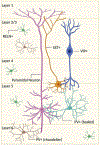GABA system as the cause and effect in early development
- PMID: 38579901
- PMCID: PMC11081854
- DOI: 10.1016/j.neubiorev.2024.105651
GABA system as the cause and effect in early development
Abstract
GABA is the primary inhibitory neurotransmitter in the adult brain and through its actions on GABAARs, it protects against excitotoxicity and seizure activity, ensures temporal fidelity of neurotransmission, and regulates concerted rhythmic activity of neuronal populations. In the developing brain, the development of GABAergic neurons precedes that of glutamatergic neurons and the GABA system serves as a guide and framework for the development of other brain systems. Despite this early start, the maturation of the GABA system also continues well into the early postnatal period. In this review, we organize evidence around two scenarios based on the essential and protracted nature of GABA system development: 1) disruptions in the development of the GABA system can lead to large scale disruptions in other developmental processes (i.e., GABA as the cause), 2) protracted maturation of this system makes it vulnerable to the effects of developmental insults (i.e., GABA as the effect). While ample evidence supports the importance of GABA/GABAAR system in both scenarios, large gaps in existing knowledge prevent strong mechanistic conclusions.
Keywords: Early development; Early life stress; Fetal alcohol syndrome; GABA; GABAA receptors; Maternal immune activation.
Copyright © 2024 Elsevier Ltd. All rights reserved.
Conflict of interest statement
Declaration of Competing Interest None
Figures



Similar articles
-
Is GABA neurotransmission enhanced in auditory thalamus relative to inferior colliculus?J Neurophysiol. 2014 Jan;111(2):229-38. doi: 10.1152/jn.00556.2013. Epub 2013 Oct 23. J Neurophysiol. 2014. PMID: 24155003 Free PMC article.
-
Role of tonic GABAergic currents during pre- and early postnatal rodent development.Front Neural Circuits. 2013 Sep 3;7:139. doi: 10.3389/fncir.2013.00139. eCollection 2013. Front Neural Circuits. 2013. PMID: 24027498 Free PMC article. Review.
-
An evolutionarily conserved switch in response to GABA affects development and behavior of the locomotor circuit of Caenorhabditis elegans.Genetics. 2015 Apr;199(4):1159-72. doi: 10.1534/genetics.114.173963. Epub 2015 Feb 2. Genetics. 2015. PMID: 25644702 Free PMC article.
-
Inhibitory synapse formation in a co-culture model incorporating GABAergic medium spiny neurons and HEK293 cells stably expressing GABAA receptors.J Vis Exp. 2014 Nov 14;(93):e52115. doi: 10.3791/52115. J Vis Exp. 2014. PMID: 25489750 Free PMC article.
-
Regulation of GABAergic neurotransmission by purinergic receptors in brain physiology and disease.Purinergic Signal. 2025 Feb;21(1):149-177. doi: 10.1007/s11302-024-10034-x. Epub 2024 Jul 24. Purinergic Signal. 2025. PMID: 39046648 Free PMC article. Review.
Cited by
-
Impairment of Skeletal Muscle Contraction by Inhibitors of GABA Transporters.Int J Mol Sci. 2024 Nov 21;25(23):12510. doi: 10.3390/ijms252312510. Int J Mol Sci. 2024. PMID: 39684222 Free PMC article.
-
GABAergic Influences on Medulloblastoma.Brain Sci. 2025 Jul 11;15(7):746. doi: 10.3390/brainsci15070746. Brain Sci. 2025. PMID: 40722337 Free PMC article. Review.
-
Early developmental changes in GABAA receptor expression in nucleus accumbens medium spiny neurons.Front Neurosci. 2024 Dec 12;18:1445162. doi: 10.3389/fnins.2024.1445162. eCollection 2024. Front Neurosci. 2024. PMID: 39726828 Free PMC article.
-
A novel de novo GABRA2 gene missense variant causing developmental epileptic encephalopathy in a Chinese patient.Ann Clin Transl Neurol. 2025 Jan;12(1):137-148. doi: 10.1002/acn3.52262. Epub 2024 Dec 31. Ann Clin Transl Neurol. 2025. PMID: 39737842 Free PMC article.
-
Nonconceptus Mechanisms of Prenatal Alcohol Exposure That Disrupt Embryo-Fetal Development: An Integrative View.Alcohol Res. 2025 Jul 16;45(1):07. doi: 10.35946/arcr.v45.1.07. eCollection 2025. Alcohol Res. 2025. PMID: 40692661 Free PMC article. Review.
References
-
- Antonov SA, Novosadova EV, Arsenyeva EL, Grefenstein MA, Zykova AA, Kobylyansky AG, Manuilova ES, Grivennikov IA, Illarioshkin SN, & Myasoedov NF (2016, Sep). Investigation of the effects of GABA receptor agonists in the differentiation of human induced pluripotent stem cells into dopaminergic neurons. Dokl Biol Sci, 470(1), 244–246. 10.1134/S0012496616050045 - DOI - PubMed
-
- Awad PN, Amegandjin CA, Szczurkowska J, Carrico JN, Fernandes do Nascimento AS, Baho E, Chattopadhyaya B, Cancedda L, Carmant L, & Di Cristo G (2018, Nov 1). KCC2 Regulates Dendritic Spine Formation in a Brain-Region Specific and BDNF Dependent Manner. Cereb Cortex, 28(11), 4049–4062. 10.1093/cercor/bhy198 - DOI - PMC - PubMed
Publication types
MeSH terms
Substances
Grants and funding
LinkOut - more resources
Full Text Sources

